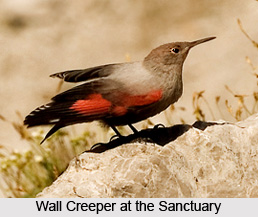 Rupi Bhaba Sanctuary is located close to Rampur Bushahr in Kinnaur District of the northern Indian state of Himachal Pradesh and is a dream destination for passionate nature lovers. It is based at an elevation of 960 to 5650 metres above mean sea level on the banks of Sutlej River. It lies adjacent to Pin Valley National Park as well as the Great Himalayan National Park and its different altitudes at various portions of the valley imparts it a flavour of uniqueness amongst the other regional wildlife sanctuaries of Himachal Pradesh. The area occupied by this sanctuary measures about 269 square kilometres, and comprises a lush green belt of forests and diverse fauna wandering amidst the rocky terrains of Rupi Bhaba Sanctuary.
Rupi Bhaba Sanctuary is located close to Rampur Bushahr in Kinnaur District of the northern Indian state of Himachal Pradesh and is a dream destination for passionate nature lovers. It is based at an elevation of 960 to 5650 metres above mean sea level on the banks of Sutlej River. It lies adjacent to Pin Valley National Park as well as the Great Himalayan National Park and its different altitudes at various portions of the valley imparts it a flavour of uniqueness amongst the other regional wildlife sanctuaries of Himachal Pradesh. The area occupied by this sanctuary measures about 269 square kilometres, and comprises a lush green belt of forests and diverse fauna wandering amidst the rocky terrains of Rupi Bhaba Sanctuary.
Flora of Rupi Bhaba Sanctuary
The sanctuary is covered by rich vegetation comprising trees like Ficus, Melotus, Banana, Chir Pine, Alpine, Kharsu, Oak, Himalayan Temperate Forests, Coniferous Forests, Dry Temperate Coniferous Forests and much more. Visitors will come across Fir and Birch trees as they approach the higher altitudes of Rupi Bhaba Sanctuary.
 The sight of numerous forests and trees create a favourable ambience for the animals residing here.
The sight of numerous forests and trees create a favourable ambience for the animals residing here.
Fauna of Rupi Bhaba Sanctuary
There exists innumerable species of wild animals in Rupi Bhaba Sanctuary including Brown Bear, Himalayan Tahr, Snow Leopard, Blue Sheep, Indian Fox, Musk Deer, Himalayan Black Bear amongst others. One will observe different colourful birds in this part of the country which consists of Black Tit, Blue Bird, Ghoral, Western Tragopan, White-Capped Redstart, Nutcracker, Streaked Laughing Thrush, Crested Black Tit, Wall Creeper, Wren, Orange-Flanked Bush Robin, Black-Throated Jay, Yellow-Billed Chough, Wagtail and several other birds.
The most ideal time to pay visit to this wildlife sanctuary is between April and September and again between the months of September and October. One will experience comfortable climate during summers, and even enjoy cool nights in the summer season within the sanctuary premises. However, winters in this region are quite chilly and it is advised that travellers must avoid visiting Rupi Bhaba Sanctuary during this time of the year as rainfall might create hazards for them especially in the lower parts of Kinnaur.



















